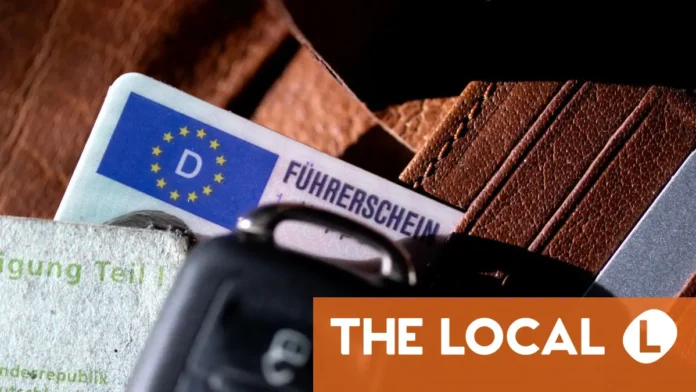If you don’t have a few thousand euros, and quite a bit of time to spare you simply can’t afford to get a driver’s licence in Germany. Here’s the Transport Ministry’s plan to bring those costs down.
The high cost to obtain a driver’s licence in Germany has long been a heated topic. So much so that, when forming their federal government coalition, the Union and Social Democrat parties even added a goal to make the process cheaper in their coalition agreement.
Now Transport Minister Patrick Schnieder (CDU) has put forward his plan for cost reduction measures that include easing some aspects of the training process, allowing for more remote learning and digital solutions and even simplifying the theoretical test structure.
How expensive is it?
The costs to earn your first driver’s licence in Germany, or even to swap your foreign licence for a German one for foreigners coming from a country without a driver’s licence exchange agreement, are manifold.
There’s the cost of driver’s education (Fahrschule) classes along with in-car practice hours with a teacher, practice materials, theory and practical exams, an eye test, a first aid course and finally the licence fee itself.
The Local listed the cost of each of the above items in an article in 2022, and found the total cost to be in the range of €2800 to €3500 for a Class B licence.
Since then, some of the basic costs have risen. According to the Transport Ministry, a class B car driver’s license currently costs between €3,400 and €4,000 or more.
Among those who have to pay these costs – whether parents of young adults or foreign adults who need to go through the process to earn a German licence – there is broad consensus that these costs have spiralled out of control.
“Mobility must not be a privilege,” said Transport Minister Patrick Schnieder on Thursday when presenting his key points for how he expects to reduce some of the burden.
READ ALSO: Which vehicles can you drive without a licence in Germany?
What’s the plan?
Schnieder has proposed a package of new regulations, which would theoretically make it easier and cheaper for driving schools to get students’ up to speed on meeting the requirements for obtaining a licence.
He also plans to simplify some of the requirements involved, which would save students from just a few of the costly in-car practice sessions with a teacher, and reduce the number of people who need to retake the theoretical test, for example.
The proposal is still up for further discussion with the states and the industry.
Advertisement
If all of Schnieder’s plans are implemented, he suspects it could amount to several hundred euros in savings for students.
The planned changes are to be launched in the first half of 2026.
READ ALSO: Can I rent a car in Germany with my foreign driver’s licence?
What would change?
The main proposals for reform include:
- Scrapping the obligation for students to receive face-to-face driver’s education lessons, and enabling students to opt for online lessons including through apps or learning platforms. This might allow driving schools to offer cheaper digital courses that wouldn’t require physical training rooms.
- Allowing more use of driving simulators in place of some in-car practice. According to the ministry, this could be used, for example, to practice driving cars with manual transmissions – which would reduce the need for driving schools to buy or maintain manual transmission vehicles in addition to automatic ones.
Advertisement
- Reducing the requirements for special in-car practice, such as hours at night or on motorways. The ministry imagines some of these special conditions sessions could also be done on a simulator, which would reduce the need for expensive additional practice sessions in a car with an instructor.
- Cutting down the catalogue of theoretical questions on the knowledge test from the current 1,169 questions to about 750, with a focus on topics more strictly relevant to road safety. The theoretical test for a German driver’s licence has a notoriously expansive catalogue of test questions, with new batches of questions having been added every six months. Simplifying the test catalogue would presumably reduce the number of student who fail and need to retake the test as well.
EXPLAINED: The changes to Germany’s driving licence theory test
- Limiting the duration of the driving portion of the practical test to 25 minutes, in accordance with European minimum requirements. According to the ADAC, a total test duration of 55 minutes is currently common.
- Making information about the costs and failure rates at all driving schools transparent and available online.
- Reducing some of the recording and documentation obligations for driving schools, as well as digitising further training for driving instructors.
Additionally, Schnieder suggested that he has an “experimentation clause” in mind to see about allowing parents or other guardians with driving experience to practice with learner drivers.
Advertisement
What do instructors say?
Some industry representatives suggest there is room to streamline driving lessons and training.
“The dramatically increasing number of driving hours is the main cost driver,” the vice-chairman of the Federal Association of Driving Instructor Associations told the Rheinische Post.
He suggests this is due to higher traffic density and “the fact that young people have a worse perception of traffic than they did 20 years ago due to smartphone use”.
Making the training process more effective would be a time and cost saver, since failing and needing to retake tests multiple times also increases costs.
Disclaimer : This story is auto aggregated by a computer programme and has not been created or edited by DOWNTHENEWS. Publisher: thelocal.de









